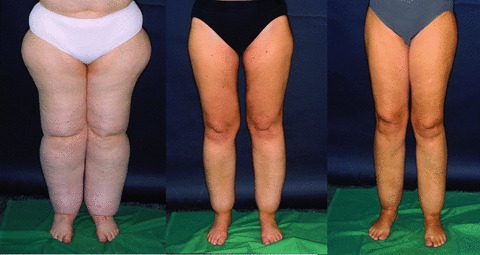If you have lipedema, weight gain is a disorder and not your fault
9 years ago | Weight
By pH health care professionals
If you’ve ever felt like no amount of dieting and exercise works on your bottom half, read on. There’s a relatively common fat disorder called lipedema, often mistaken for simple obesity. It is estimated to affect 10 million to 17 million Americans, with signature characteristics of a slim upper body with large hips and legs.
People with the condition may have been told they are obese and that they should try exercising more or try a different diet program. But lipedema fat is pretty unresponsive to diet and exercise. Through no fault of their own, their legs continue to swell in size.
Lipedema is often misdiagnosed and under-recognized. Even your doctor may be unfamiliar with it (click here for physician education). So here is what you need to know about lipedema:
Actress Beau Dunn, seen on Entourage, has lipedema. She started the Cure Lipedema Foundation.

What exactly is lipedema?
Lipedema, a disease of the lymphatic system, is an abnormal buildup of fat cells in the legs, thighs and buttocks. The fat cells continue to expand.
Normally, fat cells expand when you overeat and shrink when you diet. This is unfortunately not the case with lipedema.
Lipedema expert Dr. Stanley Rockson, professor and researcher at Stanford University, uses the analogy of a bank to explain how the cells in lipedema patients work. “They’re a very unusual bank, because they accept deposits but no withdrawals,” he told NPR. “So once they accumulate material, it never comes out again.”
Lipedema is sometimes confused for lymphedema, a lymphatic drainage problem that leads to fluid buildup. They are not one in the same; however, lipedema can progress and cause lymphedema (fluid buildup).
Causes of lipedema
Lipedema is seen almost exclusively in females. It may be an inherited condition, hormonally triggered around puberty, pregnancy, perimenopause or periods of major stress.
Lipedema has only been recognized since 1940, and much more research is still needed. However, there has been growing interest in lymphatic diseases like lipedema, so keep an eye out for further research that helps us better understand the causes.
Treatment for lipedema
Currently, the treatment options that are recommended for lipedema include liposuction and non-surgical treatments such as compression therapy, low-impact exercises and massage therapy.
You can search locally for doctors that are knowledgeable and experienced in treating lipedema. If you need help, consider using a patient advocate.
Enjoy Your Healthy Life!
The pH professional health care team includes recognized experts from a variety of health care and related disciplines, including physicians, health care attorneys, nutritionists, nurses and certified fitness instructors. To learn more about the pH Health Care Team, click here.







